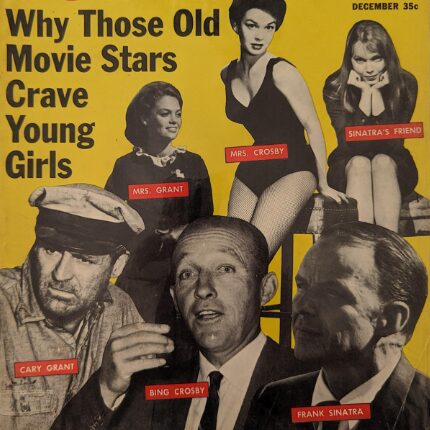Confidential magazine wasn’t just America’s most scandalous tabloid. It was a blueprint for weaponized gossip. The kind that didn’t just destroy careers. It destroyed people. Women, queer folks, Black entertainers, interracial couples. All of these marginalized groups became clickbait before the internet even existed.
Launched in 1952 by publisher Robert Harrison, Confidential promised to “tell the facts and name the names” but what it really did was sling scandal, shame and suspicion at anyone who didn’t fit mid-century America’s straight, white, conservative ideal. While studio PR machines protected powerful male stars, Confidential magazine hunted easier targets: women, people of color and queer performers. The more vulnerable you were, the bigger the headline.
The magazine’s circulation soared into the millions, making it the most influential gossip rag of its time. But its power wasn’t just in how many people read it. It was in how it could silence, blackball, or humiliate with a single story. It trafficked in half-truths, racial coding, sexual innuendo, and flat-out character assassination. And for a while, it was untouchable.
Until it wasn’t.
By 1957, Confidential faced a massive criminal libel trial in Los Angeles, with stars like Maureen O’Hara and Liberace taking the stand. The magazine was accused of fabricating stories, ruining lives, and ignoring all ethical boundaries. Though Harrison avoided jail time through a last-minute plea deal, the trial damaged the magazine’s credibility and profitability. Distribution dropped. Lawsuits mounted. By the early 1960s, Confidential magazine faded into obscurity.
But its damage didn’t disappear.
Confidential Magazine, They Named the Names
But Only the Ones Who Couldn’t Fight Back
Confidential magazine thrived off imbalance. It went after people the studios refused to protect—actresses with “bad reputations,” queer actors, Black performers, women of color. The stories weren’t always true, but the fallout always was. It wasn’t about truth. It was about who had the least power to push back.
If a white male star had a mugshot, it became part of his charm. He was rebranded as troubled, not toxic. If a woman dated someone “beneath” her, it was spun as a breakdown. If a Black man loved a white woman, the relationship was framed like a crisis. And if a gay man dared to exist in public? He didn’t need to be caught doing anything. The suggestion alone was enough to wreck him.
They didn’t name the powerful. They named the vulnerable. They named the ones who couldn’t afford lawyers or PR clean-up. They named the people already standing on the edge and gave them a push. It wasn’t journalism. It was punishment with a print run.
It wasn’t just about humiliation. It was erasure. They erased names, flattened stories, twisted lives into single lines of tabloid bait. The real scandal wasn’t what the stars did. It was how this magazine chose who got to survive the story.
Hollywood’s Double Standard in Headlines:
“Same Sin, Different Spin”
Let’s take a look at the receipts:
1. Rory Calhoun: “But for the Grace of God, Still a Convict”
When a white male actor had a criminal record, he wasn’t canceled. He was romanticized. His mugshot became part of his mythology. It wasn’t shameful. It was seductive. He was rebranded as a reformed bad boy, not a liability.
2. Joan Crawford: “Back Street Romance With a Bartender”
Meanwhile, a powerful woman who dated a working-class man? She was portrayed as desperate, damaged, and slumming. Her romance was never allowed to be human. It had to be evidence of decline.
3. Sammy Davis Jr. and May Britt: “Will Hollywood Blackball Them?”

Their relationship was treated like a threat. The real scandal wasn’t that they were in love, it was that America couldn’t stomach a Black man and a white woman together. And Confidential knew exactly how to pour gasoline on that fire.
4. Marlon Brando and His “Tan Tootsie”
Interracial relationship? Brando got painted as a reckless playboy. She didn’t even get a name, just racist shorthand. It wasn’t about love or even scandal. This was about control. His sin was forgivable. Hers wasn’t even acknowledged.

5. Frank Sinatra: “Tarzan of the Boudoir”
When men had a long list of lovers, they were seen as legends. Sinatra’s bedpost notches were brag-worthy, not damaging. His womanizing was something to envy, not condemn.
6. Marilyn Monroe: “Why Marilyn Can’t Ignore Those Stories Anymore”
But when women were rumored to be involved with powerful men? They were framed as unstable, manipulative, or broken. Marilyn wasn’t just sexualized. Monroe was blamed for every story written about her, even the lies.
7. Tab Hunter: “Dog Beater?”
In a time when you couldn’t print “gay” without getting sued, the magazine turned to character assassination. Tab Hunter wasn’t called queer. He was called dangerous. They couldn’t say he was gay, so they accused him of cruelty instead.
8. Liberace: “Mad About the Boy”
With Liberace, Confidential used campy innuendo to imply everything while saying nothing. The goal wasn’t to inform. It was to humiliate. They made his flamboyance the punchline, while never naming the truth behind their mockery.
9. Tallulah Bankhead: “Six Days and Nights With Tallulah”
Tallulah’s drinking was portrayed as tragic and chaotic. Same behavior as her male peers. There was booze, partying and wild nights but she was framed as pathetic. The men got laughs. The openly bisexual woman got judgment.
10. Gary Cooper: “Lost Weekend With Anita Ekberg”
When Cooper partied, it was painted as charming. The exact same behavior as Tallulah’s but because he was a man, it was an adventure, not a warning sign. He gets a chuckle. She gets slut-shamed.
11. “Will Your Wife or Girl Go Bare-Breasted?”
As women claimed more autonomy over their bodies, the magazine treated it like a national emergency. The real fear wasn’t nudity. It was women making choices without male approval.
12. Jane Fonda, Julie Christie, Ursula Andress, Jeanne Moreau: “Why More and More Stars Are Living in Sin”
These women lived openly, had relationships, and didn’t apologize for it. So the press called it a moral crisis. They weren’t just shamed. They were accused of eroding the fabric of society just for having control over their own damn lives.
13. Elizabeth Taylor and Mike Todd
He was the one allegedly fooling around, but guess whose name made the headline? Hers. Because in the world of Confidential, a man’s bad behavior was her burden. She wasn’t the cheater, but she got framed like the accomplice. That’s how this magazine worked. It didn’t just expose affairs, it assigned shame. And it almost always handed it to the woman.
14. Cary Grant, Bing Crosby, Frank Sinatra… and their “young companions”
This headline practically winks at the audience while framing grown men dating (or preying on) significantly younger women as something cheeky or charming. The men are named and respected. The women? Stripped of identity and referred to only in relation to the men: “Mrs. Crosby” and “Sinatra’s Friend.” Because god forbid we recognize them as people with agency or names.
This wasn’t concern. It was normalization of power imbalance, wrapped in faux curiosity. The women were decorative. The men were just doing what men do.
What Confidential Left Behind:
The Legacy and the Wreckage
Confidential magazine didn’t just vanish. It left fingerprints on everything that came after it. Today’s tabloids still follow the same blueprint: dehumanize, sensationalize, sell. Swap newsstands for Instagram reels and you’ve got the same cycle of public takedown disguised as entertainment. Back then it was “Living in Sin” and “Dog Beater?” Today it’s blurry paparazzi shots and anonymous tip-offs. Different format. Same violence.
The people Confidential targeted rarely got the chance to fight back. Dorothy Dandridge was blacklisted and shamed for loving freely. Tab Hunter lived most of his life in the closet. Liberace sued and won, but never escaped the mockery. May Britt walked away from Hollywood entirely. These weren’t just gossip casualties. They were real people caught in a machine that profited off their silence and pain.
The headlines may have faded but the damage didn’t. This wasn’t harmless drama. It was career sabotage. Mental health destruction. Public humiliation at scale. And it was legal. What passed for journalism in Confidential’s pages was cruelty dressed up as public interest.
You still see it today. Every time a Black woman is labeled “difficult,” every time a queer person is outed without consent, every time an actress is blamed for a breakup, you’re seeing the ghost of Confidential. It didn’t die. It just rebranded.
When the Gossip Machine Got Sued
By the mid-1950s Confidential magazine was unstoppable. It boasted millions of readers, outsold Time and Newsweek combined, and had every publicist in Hollywood on edge. But it wasn’t just the public that was watching. Lawyers were, too.
The magazine had already racked up a pile of lawsuits, but things exploded in 1957 when the State of California charged Confidential with criminal libel. Not civil. Criminal. That’s how serious it got. The trial dragged in A-list names like Liberace, Maureen O’Hara, and Dorothy Dandridge. Some testified, others wanted nothing to do with the media circus. Either way, it was clear the magazine’s run as untouchable was over.
Robert Harrison, the publisher, managed to dodge jail time with a shady plea deal, but the damage was done. Distribution dried up. Advertisers pulled out. The court of public opinion started to shift. By the early 1960s Confidential was a ghost of itself. It limped along for a few more years, but its power was gone. So was the fear it once commanded.
Still, it took the full weight of the legal system and public humiliation to bring it down. Not because people suddenly cared about truth, but because Confidential finally went too far and picked the wrong targets. When powerful white actors got burned, the system suddenly remembered how lawsuits worked.
The Ghost of Confidential Still Sells
Confidential magazine might be gone, but its playbook is still in circulation. The gossip didn’t disappear. It moved online. The headlines got shorter, the tone got meaner, and the takedowns got faster. What used to take a week to publish now happens in real time on TMZ, TikTok, and anonymous blogs. It’s still the same formula. Shame people. Sell clicks. Repeat.
When Perez Hilton hit the scene in the early 2000s, he basically brought Confidential back with glitter and digital graffiti. He outed queer celebrities without consent. He posted unflattering photos of women and labeled them “trainwrecks.” TMZ followed with its own brand of gotcha journalism. Less pink, more police blotter. They chased stars through airports and shoved cameras into grieving faces. Now it’s evolved again. Tip accounts. Reddit threads. YouTube gossip reactors. TikTok drama channels. Gossip is faster and meaner than ever. It never left. It just changed clothes.
The targets changed too. It’s not just celebrities anymore. Influencers get torn apart. Sex workers have private content leaked without consent. Women still get blamed for breakups they didn’t cause. Queer people still get outed before they’re ready. We just stopped pretending it was journalism. Now we call it content.
This was never harmless. It wasn’t then and it isn’t now. Confidential magazine created a culture where cruelty is entertainment. Until we stop rewarding that, the gossip machine will keep spinning. Different platform. Same poison.














Leave a Reply